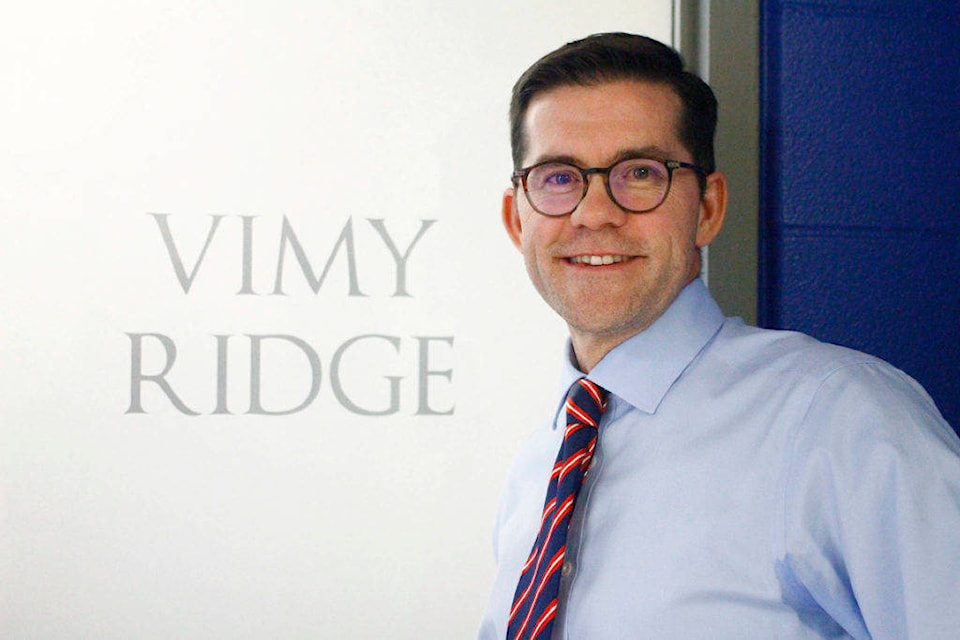Ponoka Secondary Campus teacher Ron Labrie reflects on the “Canadian Battlefields Tour” in 2005, that started PSC on their Ponoka Cenotaph Project and activism for remembrance.
It has always been a dream of mine to visit the war cemeteries in Europe. My early interest in war history has turned into a passion for understanding the volunteer commitment of Canadians in the two world wars. I was honoured and elated to attend a battlefield tour sponsored by Veteran Affairs, The Canadian Battlefields Foundation and Historica. The tour took us to Northern France, Belgium, Holland and Germany. It was a great professional opportunity to engage with teachers across the country and absorb the expertise of Associate Professor Geoff Hayes, Alexandre Carette, and Blake Seward.
My students will no doubt benefit from my new-found knowledge and emotion that resulted from this experience. In particular, the endless opportunities for remembrance of thousands of young men that paid the ultimate sacrifice and the significance of Canadian participation in the World Wars.
The challenge of our young men and their bravery is astonishing, yet many times forgotten and/or misrepresented. It seems that many Canadians do not know the significance of these missions that would age our Canadian boys beyond their years or… end their lives. We have witnessed the emotion and unwavering respect of many Western Europeans who were liberated by Canadian soldiers. It is imperative that I share the battlefield tour experience with my community with the hope that they gain the same respect and admiration for our fallen Canadians as the citizens of these liberated countries.
When citizens focus on fallen soldiers and war deaths the concept of remembrance becomes paramount. As I walked through the numerous military cemeteries all over Northwest Europe, I observed the graves of thousands of fallen soldiers. Their entire identity portrayed on a tombstone with only their name, regimental number and date of death. It was emotionally draining to internalize the sheer number of losses of men in the prime of their lives.
Upon reflection of my experiences and the enormity of emotion that was associated with this experience, I have come to the realization that I have a duty to remember:
Every fallen soldier was someone’s son, husband, or brother. Underneath every grave is a story of a man (many of them boys) who believed that they were part of the solution in fighting a greater evil.
The multitude of WWI and WWII war cemeteries seemingly everywhere throughout Northern France, Belgium and Holland. Many of them in the middle of nowhere. At the time, buried where they died, but now they exist behind a deserted church or in the middle of a cornfield.
The immaculate condition of these sacred grounds preserved to perfection by the Commonwealth War Graves Commission; flowers were in full bloom and the grass was green and manicured. Citizens from all nations visit these cemeteries evident from the signatures in the guest registrant book.
Visiting Langemark German military cemetery in Belgium. It was rewarding to see a busload of German students scrubbing and polishing the gravestones of 29,000 World War I German soldiers, 83 years after their death.
Observing 26,000 crosses at Notre Dame de Lorette where the bodies of WW I French Soldiers took their last breath.
8:00 pm at the Menin Gate where the community continues their nightly ritual of playing the Last Post in recognition of the enormous sacrifice in and around Ypres, Belgium during WW I. On the memorial one can read the engraved names of 59,000 Commonwealth Soldiers, 9,000 of them Canadian. They have no known grave.
Seeing titles that were much more ambiguous, “A Soldier of the Great War” and “Known Only unto God.” I wondered who he was and where he was from. I wondered what it must have been like for his family to not ever know where his final resting place would be.
Walking down the Grange tunnel at Vimy Ridge trying to imagine what it would have felt like in 1917, walking towards the front-line trenches and the German forces only 25 metres away.
Evert Stieber and Adele Bouman (Dutch Citizens) who traveled with us throughout the tour and shared their emotions regarding the significance of the Canadians in the liberation of the Netherlands; in particular, their tearful presentation of W. Arsenault who was killed in the liberation of their community- Zwolle, Netherlands.
Gordon Joseph Brady; son of Michael Joseph and Anna Margaret Brady, of Ponoka, Alberta. Gordon Brady, Warrant Officer Class II, R93554, was an air gunner on a Lancaster bomber. He was attached to the secretive 617 (RAF) Squadron (the Dambusters). He was shot down on May 17, 1943 and is buried in Bergen Op Zoom Cemetery in Holland. As a result of his attachment to an RAF Squadron, he is buried in the British cemetery.
Giving a presentation about his life in front of my colleagues and thinking that … he likely has never had a presentation such as this before nor will he again. His young death and the fact that he did not marry before the war, comes the realization that future generations of his likeness will never be. I wanted to leave a little piece of Canada with him, so I gave him a five-cent victory memorial coin, said a prayer and made a commitment to remember.
“They shall grow not old, as we that are left grow old; Age shall not weary them, nor the years condemn. At the going down of the sun and in the morning, we will remember them.” — Laurence Binyon.
- Written by Ron Labrie, Ponoka, Alberta
